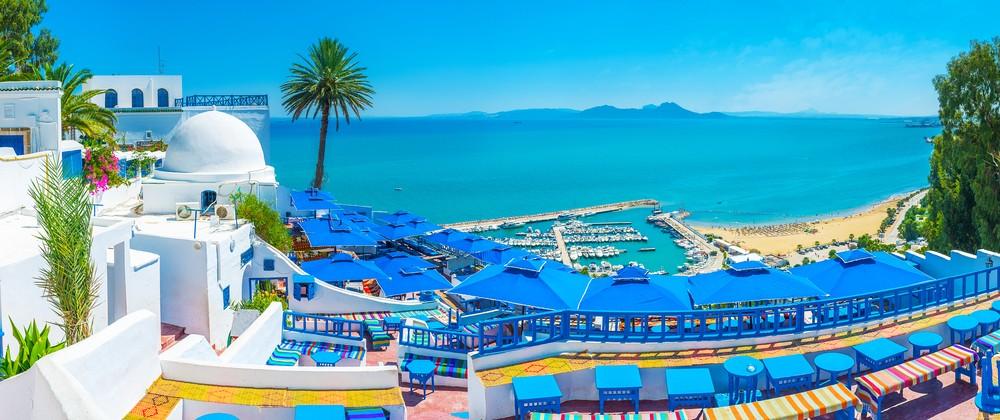This backdrop would also do honor to a feature film. A caravan of tourists moves along the edge of the El Hofra dunes not far from the Tunisian oasis of Douz. It is the “gateway to the Sahara”, and those who leave the periphery of the small desert town behind and have become accustomed to the rocking gait of the camels will very soon be trapped by sand, sun and an incredible silence. The largest dry desert on earth extends over enormous dimensions – from the Moroccan Atlantic coast to the Red Sea.
And Tunisia is one of the countries where life in the desert determines the everyday life of the people who live there. A trip through this region of North Africa gives the holidaymaker an exciting mixture of a diverse landscape with countless historical treasures and an amazingly modern culture. Tunisia has much more to offer than just spending time on the beaches of the Mediterranean. The country is also recommended for trekking tours to shady oases, to the testimonies of the Roman era or to wondrous rock gardens. They are all tourist highlights in Tunisia.

Between the 12th and 16th centuries, the capital Tunis was one of the most important metropolises in the Islamic world. Its history is closely linked to the rise and fall of the ancient trading republic of Carthage, which finally had to recognize Roman hegemony in the Mediterranean region after Hannibal’s defeat in the Battle of Zama. There, as once Carthage’s center of power was located, today are the villas of a suburb of Tunis. Only the ruins of history remain, and the people of this area are convinced that every stone that can be found there is like a book and every pillar bears witness to history. In its heyday, Carthage was the North African hub of literature and art.
Anyone who visits the remains of Carthage as a holidaymaker today will be amazed at the numerous luxury cars in front of the magnificent white houses on the way to the old castle hill. They bear witness to the considerable prosperity of their owners and are in stark contrast to the poor districts of Tunis and the rest of the country. Around thirty years ago, the capital began the restoration of its medina, which is now one of the best-preserved historic districts in North Africa. In the throng of people beyond the Bab-el-Bahr city gate, the imposing Djamaa Ez-Zitouna mosque cannot be overlooked. In the neighboring Souk El Attarine, perfume merchants have always settled, offering essences and incense, among other things. The entire old town of Tunis was declared a UNESCO World Heritage Site in 1979.

It is about 130 kilometers from Tunis to the port city of Sousse, which is surrounded by a medieval city wall. It was founded by the Phoenicians and largely destroyed by the Arabs in the 7th century. With its modern hotels and 40,000 guest beds, Sousse is a tourist heavyweight in Tunisia. UNESCO also ennobled the old town there with an entry in the World Heritage List.
Douz is a good starting point for activities in the Sahara. The area around the city is inhabited by the semi-nomadic tribe of the Mrazig, who offer their products at the weekly market of Douz. They range from the traditional jewellery of the Berbers to chickens, camels and the Slougis, a dog breed that originated in Morocco and is now valued as an oriental greyhound breed all over North Africa. If you are a holidaymaker lucky enough to be in Douz at the end of December, you can enjoy the international Sahara Festival. It enchants for four days with dances, music, dog races and the traditional camel wrestling.
Trekking tours through Tunisia are the encounter with the silence and solitude of the Sahara. And if you leave the infinity of the desert regions and enter one of the shady oases, you will be almost paralyzed after days under the blazing sun and enduring heat and dust under the palm roofs. Some people are then inclined to greet each of these palms individually and joyfully.
The island of Djerba also invites sun-seekers to relax.
Travel information Tunisia
| Capital | Tunis |
|---|---|
| Form of government | Republic semi-presidential system |
| Currency | Tunisian dinar (TND) |
| Area | approx. 163,610 km² |
| Population | approx. 11,299,400 (2016 est.) |
| Languages | Arabic |
| Electricity grid | 230 volts, 50 Hz |
| Area code | +216 |
| Time zone | UTC+1 CET UTC+2 CEST (March to October) |


